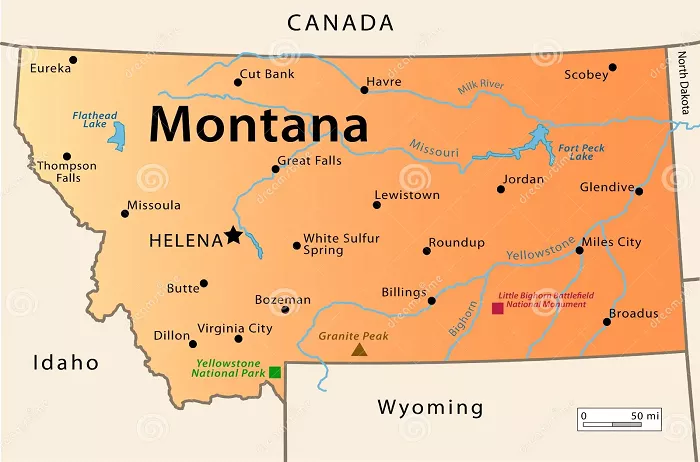Montana, often referred to as “Big Sky Country,” is a state located in the northwestern region of the United States. Known for its vast plains, majestic Rocky Mountains, and rich history, Montana offers a unique blend of natural beauty and cultural significance.
Geographical Location of Montana
Montana is bordered by several U.S. states and Canadian provinces, highlighting its strategic position in the northern Rockies.
Neighboring States and Provinces
- North: Montana shares its northern border with the Canadian provinces of British Columbia, Alberta, and Saskatchewan.
- East: To the east, Montana is bordered by North Dakota and South Dakota.
- South: Wyoming lies to the south of Montana.
- West: Idaho is located to the west of Montana.
Dimensions and Area
Montana is the fourth-largest state in the U.S., covering an area of approximately 147,042 square miles (380,800 square kilometers). To put this into perspective, Montana’s size is comparable to countries like Japan, the United Kingdom, and Germany.
Major Geographical Features
The state’s diverse terrain includes:
- Western Region: Dominated by the Rocky Mountains, this area features numerous mountain ranges and valleys, offering rich forests and diverse wildlife.
- Central Region: Known as the “Central Front,” this zone acts as a transition between the mountains and the plains, featuring isolated mountain ranges, prairies, and badlands.
- Eastern Region: Characterized by the Great Plains, this area consists of expansive prairies and rolling hills, providing a stark contrast to the mountainous west.
Key Cities and Landmarks
Montana’s cities and landmarks contribute significantly to its cultural and economic landscape:
- Helena: The state capital, located in the western part of the state, is nestled in the foothills of the Big Belt Mountains.
- Billings: As Montana’s largest city, Billings serves as a major financial and retail center, earning the nickname “Magic City” due to its rapid growth.
- Glacier National Park: Situated in the northwest, this park is renowned for its stunning glaciers, diverse ecosystems, and scenic drives.
- Yellowstone National Park: Extending into Montana’s southern border, this iconic park is famed for its geothermal features and abundant wildlife.
Transportation and Accessibility
Montana’s vast size and varied terrain influence its transportation networks:
- Highways: Major interstate highways, such as I-90 and I-15, traverse the state, facilitating east-west and north-south travel.
- Railroads: Montana’s history is deeply rooted in rail transport, with several active rail lines supporting both passenger and freight services.
- Airports: Major airports in cities like Billings, Missoula, and Great Falls connect Montana to national and international destinations.
Climate and Weather Patterns
Montana experiences a continental climate, characterized by:
- Western Region: This area receives more precipitation due to its mountainous terrain, with some regions experiencing temperate rainforest conditions.
- Eastern Region: The plains are generally drier, with more extreme temperature variations between summer and winter.
Economic Activities
Montana’s economy is diverse, with key sectors including:
- Agriculture: The eastern plains are ideal for wheat and barley farming, while livestock ranching is prevalent statewide.
- Tourism: Attractions like national parks, fishing, and winter sports draw millions of visitors annually.
- Energy: The state possesses significant coal, oil, and natural gas reserves, contributing to its energy sector.
Cultural Significance
Montana’s cultural heritage is rich and varied:
- Native American Tribes: The state is home to several tribes, including the Crow, Cheyenne, and Assiniboine, each with distinct traditions and histories.
- Historical Sites: Landmarks such as the Little Bighorn Battlefield National Monument commemorate significant events in American history.
- Festivals and Events: Annual events like the Montana Folk Festival and various rodeos celebrate the state’s traditions and community spirit.
Educational Institutions
Montana hosts several institutions of higher learning:
- University of Montana: Located in Missoula, it offers a wide range of undergraduate and graduate programs.
- Montana State University: Based in Bozeman, it is known for research in agriculture, engineering, and environmental sciences.
Conclusion
Montana’s unique position on the map, coupled with its diverse landscapes and rich cultural heritage, make it a state of significant geographical and historical importance. Whether you’re interested in outdoor adventures, historical explorations, or experiencing vibrant local cultures, Montana offers a wealth of opportunities.

